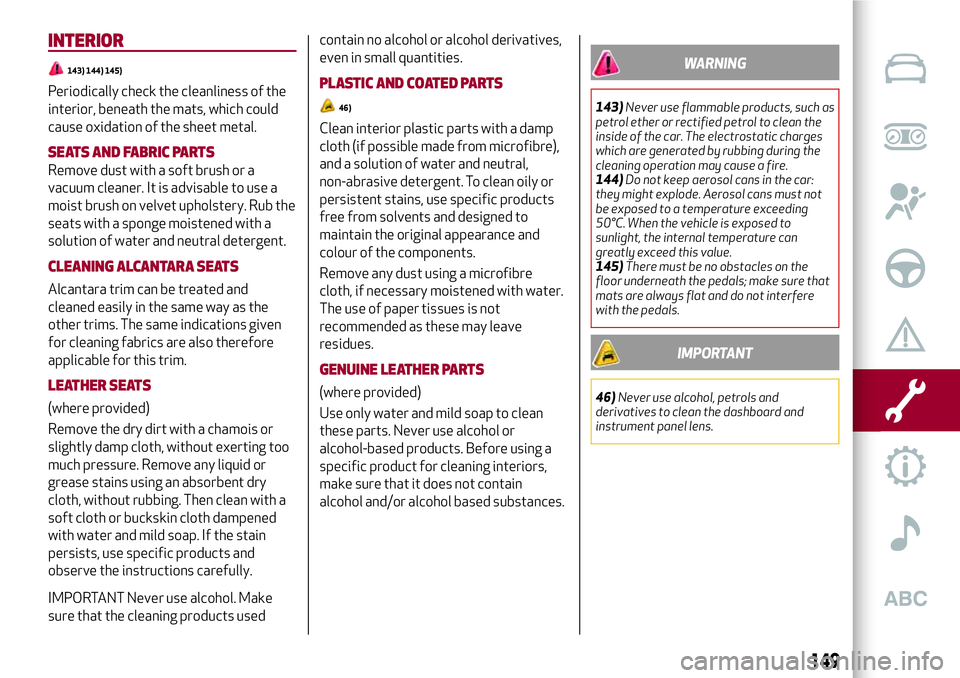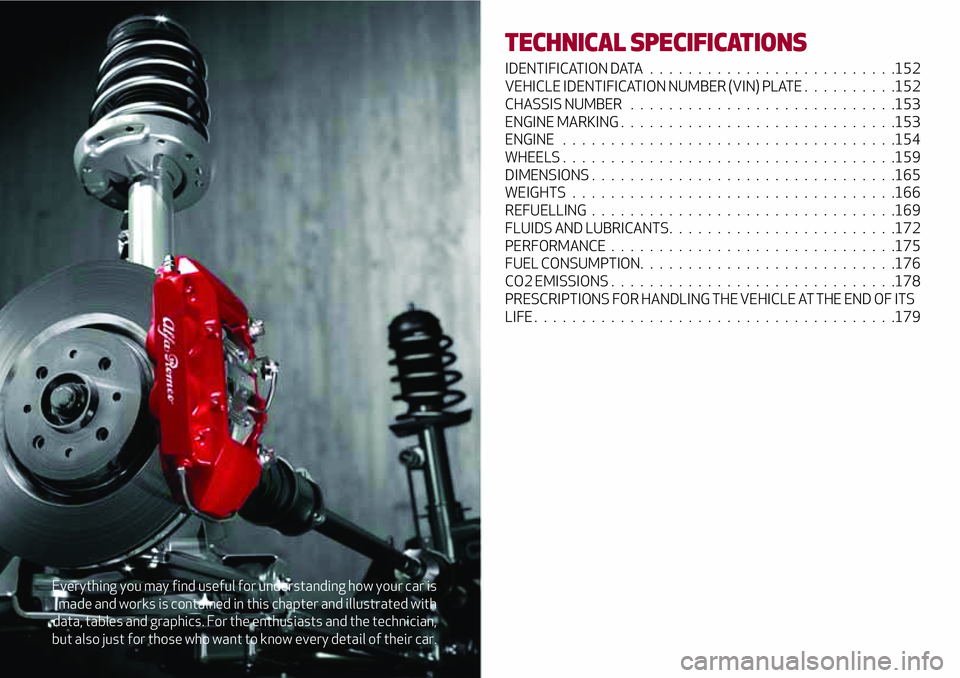Alfa Romeo MiTo 2020 Owner handbook (in English)
Manufacturer: ALFA ROMEO, Model Year: 2020, Model line: MiTo, Model: Alfa Romeo MiTo 2020Pages: 212, PDF Size: 5.18 MB
Page 151 of 212

INTERIOR
143) 144) 145)
Periodically check the cleanliness of the
interior, beneath the mats, which could
cause oxidation of the sheet metal.
SEATS AND FABRIC PARTS
Remove dust with a soft brush or a
vacuum cleaner. It is advisable to use a
moist brush on velvet upholstery. Rub the
seats with a sponge moistened with a
solution of water and neutral detergent.
CLEANING ALCANTARA SEATS
Alcantara trim can be treated and
cleaned easily in the same way as the
other trims. The same indications given
for cleaning fabrics are also therefore
applicable for this trim.
LEATHER SEATS
(where provided)
Remove the dry dirt with a chamois or
slightly damp cloth, without exerting too
much pressure. Remove any liquid or
grease stains using an absorbent dry
cloth, without rubbing. Then clean with a
soft cloth or buckskin cloth dampened
with water and mild soap. If the stain
persists, use specific products and
observe the instructions carefully.
IMPORTANT Never use alcohol. Make
sure that the cleaning products usedcontain no alcohol or alcohol derivatives,
even in small quantities.
PLASTIC AND COATED PARTS
46)
Clean interior plastic parts with a damp
cloth (if possible made from microfibre),
and a solution of water and neutral,
non-abrasive detergent. To clean oily or
persistent stains, use specific products
free from solvents and designed to
maintain the original appearance and
colour of the components.
Remove any dust using a microfibre
cloth, if necessary moistened with water.
The use of paper tissues is not
recommended as these may leave
residues.
GENUINE LEATHER PARTS
(where provided)
Use only water and mild soap to clean
these parts. Never use alcohol or
alcohol-based products. Before using a
specific product for cleaning interiors,
make sure that it does not contain
alcohol and/or alcohol based substances.
WARNING
143)Never use flammable products, such as
petrol ether or rectified petrol to clean the
inside of the car. The electrostatic charges
which are generated by rubbing during the
cleaning operation may cause a fire.
144)Do not keep aerosol cans in the car:
they might explode. Aerosol cans must not
be exposed to a temperature exceeding
50°C. When the vehicle is exposed to
sunlight, the internal temperature can
greatly exceed this value.
145)There must be no obstacles on the
floor underneath the pedals; make sure that
mats are always flat and do not interfere
with the pedals.
IMPORTANT
46)Never use alcohol, petrols and
derivatives to clean the dashboard and
instrument panel lens.
149
Page 152 of 212

150
This page is intentionally left blank
Page 153 of 212

Everything you may find useful for understanding how your car is
made and works is contained in this chapter and illustrated with
data, tables and graphics. For the enthusiasts and the technician,
but also just for those who want to know every detail of their car.
TECHNICAL SPECIFICATIONS
IDENTIFICATION DATA..........................152
VEHICLE IDENTIFICATION NUMBER (VIN) PLATE . . . . ......152
CHASSIS NUMBER . . . . . .......................153
ENGINE MARKING . . . . . ........................153
ENGINE...................................154
WHEELS...................................159
DIMENSIONS . . ..............................165
WEIGHTS..................................166
REFUELLING................................169
FLUIDS AND LUBRICANTS. . . .....................172
PERFORMANCE . . . . . . . . . . . . . .................175
FUEL CONSUMPTION. . . . . ......................176
CO2 EMISSIONS . . . . ..........................178
PRESCRIPTIONS FOR HANDLING THE VEHICLE AT THE END OF ITS
LIFE......................................179
Page 154 of 212

IDENTIFICATION DATA
The identification data of the vehicle are:
VIN plate;
Chassis marking;
Bodywork paint identification plate;
Engine marking.
VEHICLE IDENTIFICATION
NUMBER (VIN) PLATE
This plate is fitted to the engine
compartment front crossmember and
contains the following identification data
fig. 129:
TO: Name of Manufacturer
B: Type-approval number
C: Vehicle type identification code
D: Chassis number
E: Maximum permitted weight of vehicle
fully laden
F: Maximum permitted weight of vehicle
fully laden plus trailer
G: Maximum permitted weight on front
axle
H: Maximum permitted weight on second
(rear) axle
I: Engine type
L: Bodywork version codeM: Spares number
N: Smoke opacity index (for diesel
engines)
129A0J0161C
152
TECHNICAL SPECIFICATIONS
Page 155 of 212

CHASSIS NUMBER
This is printed on the passenger
compartment floor, next to the front
right seat.
Slide flap 1 fig. 130 to access.
The marking includes:
vehicle type (ZAR 955000);
chassis serial number.
ENGINE MARKING
It is stamped on the cylinder block and
includes the type and the engine serial
number.
130A0J0140C
153
Page 156 of 212

ENGINE
GENERAL INFORMATION Turbo TwinAir 105 HP Turbo TwinAir 100 HP(*)
Engine code 199B6000 199B7000
CycleOtto Otto
Number and position of cylinders 4 in line 4 in line
Piston bore and stroke (mm) 80.5 × 86 72.0 × 84.0
Total displacement (cm³) 875 875
Compression ratio 10 10
NATURAL DYNAMIC
Maximum power (EC) (kW) 72 77 73.5
Maximum power (EEC) (HP) 98 105 100
corresponding engine speed (rpm) 5750 5500 5500
Maximum torque (EC) (Nm) 120 145 145
Maximum torque (EC) (kgm) 12.2 14.8 14.8
corresponding engine speed (rpm) 1750 2000 2100
Spark plugs NGK ILKR9G8 NGK ILKR9G8
FuelUnleaded petrol 95 R.O.N. (EN
228 specifications)Unleaded petrol 95 R.O.N. (EN
228 specifications)
(*) Version for specific markets
154
TECHNICAL SPECIFICATIONS
Page 157 of 212

GENERAL INFORMATION 1.4 Petrol 8V 78 HP 1.4 Turbo Petrol/LPG 120 HP
Engine code 350A1000 198A4000
Cycle Otto Otto
Number and position of cylinders 4 in line 4 in line
Piston bore and stroke (mm) 72.0 × 84.0 72.0 × 84.0
Total displacement (cm³) 1368 1368
Compression ratio 11.1 9.8
LPG PETROL
Maximum power (EC) (kW) 57 88 88
Maximum power (EEC) (HP) 78 120 120
corresponding engine speed (rpm) 6000 5000 5000
Maximum torque (EC) (Nm) 115 206 206
Maximum torque (EC) (kgm) 11.7 21 21
corresponding engine speed (rpm) 3000 1750 2000
Spark plugs NGK ZKR7AI-8 NGK IKR9J8
Fuel Unleaded petrol 95 R.O.N.
(EN 228 specifications)LPG
(EN589Unleaded
petrol
95 R.O.N. (EN
228 specifications)
155
specification)
Page 158 of 212

GENERAL INFORMATION 1.4 Turbo MultiAir 135 HP 1.4 Turbo Multi Air 135/140 HP TCT
Engine code 955A2000955A7000 (*)
955B1000 (**)
Cycle Otto Otto
Number and position of cylinders 4 in line 4 in line
Piston bore and stroke (mm) 72.0 × 84.0 72.0 × 84.0
Total displacement (cm³) 1368 1368
Compression ratio 9.8 9.8
Maximum power (EC) (kW) 99 99 (*) / 103 (**)
Maximum power (EEC) (HP) 135 135 (*) / 140 (**)
corresponding engine speed (rpm) 5000 5000
NATURAL DYNAMIC NATURAL DYNAMIC
Maximum torque (EC) (Nm) 190 206 230 250
Maximum torque (EC) (kgm) 19.3 21 23.4 25.5
corresponding engine speed (rpm) 4250 1750 2250 2500
Spark plugs NGK IKR9F8 NGK IKR9J8
FuelUnleaded petrol 95 R.O.N. (EN
228 specifications)Unleaded petrol 95 R.O.N. (EN
228 specifications)
(*) 1.4 Turbo Multi Air 135 HP TCT version (where provided)
(**) 1.4 Turbo Multi Air 140 HP TCT version
156
TECHNICAL SPECIFICATIONS
Page 159 of 212

GENERAL INFORMATION 1.4 Turbo MultiAir 170 HP 1.4 Turbo MultiAir 170 HP TCT
Engine code 940A2000 940A2000
Cycle Otto Otto
Number and position of cylinders 4 in line 4 in line
Piston bore and stroke (mm) 72.0 × 84.0 72.0 × 84.0
Total displacement (cm³) 1368 1368
Compression ratio 9.8 9.8
Maximum power (EC) (kW) 125 125
Maximum power (EEC) (HP) 170 170
corresponding engine speed (rpm) 5000 5000
NATURAL DYNAMIC NATURAL DYNAMIC
Maximum torque (EC) (Nm) 230 250 230 250
Maximum torque (EC) (kgm) 23.4 25.5 23.4 25.5
corresponding engine speed (rpm) 2250 2500 2250 2500
Spark plugs NGK IKR9J8 NGK IKR9J8
FuelUnleaded petrol 95 R.O.N. (EN
228 specifications)Unleaded petrol 95 R.O.N. (EN
228 specifications)
157
Page 160 of 212

GENERAL INFORMATION 1.3 JTDM-290 HP(*)1.3 JTDM-295 HP
Engine code 955B2000 330A1000
Cycle Diesel Diesel
Number and position of cylinders 4 in line 4 in line
Piston bore and stroke (mm) 69.6 × 82 69.6 × 82
Total displacement (cm³) 1248 1248
Compression ratio 16.8 16.8
Maximum power (EC) (kW) 66 70
Maximum power (EEC) (HP) 90 95
corresponding engine speed (rpm) 3750 3750
Maximum torque (EC) (Nm) 200 200
Maximum torque (EC) (kgm) 20.4 20.4
corresponding engine speed (rpm) 1500 1500
FuelDiesel for motor vehicles
(EN590 Specification)Diesel for motor vehicles
(EN590 Specification)
(*) Version for specific markets
158
TECHNICAL SPECIFICATIONS